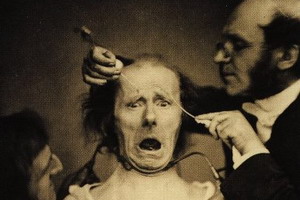 Guillaume-Benjamin Duchenne, known as Duchenne de Boulogne (17 September 1806 in Boulogne-sur-Mer – September 15, 1875 in Paris), is a French neurologist doctor. It is one of the great clinicians of the 19th century and the founder of Neurology.
Guillaume-Benjamin Duchenne, known as Duchenne de Boulogne (17 September 1806 in Boulogne-sur-Mer – September 15, 1875 in Paris), is a French neurologist doctor. It is one of the great clinicians of the 19th century and the founder of Neurology.
Biography
He completed his secondary studies at Douai, studied medicine in Paris and returned in 1831 in his hometown to carry on his profession. In 1833, he experimented with the therapeutic use of electricity on fishermen. In 1842, he moved to Paris where he spent the rest of his life to develop clinical applications of electricity. Physician without official hospital status, he impressed by the rigour of his experiences, which earned him the part of Jean – Martin Charcot the title of “master”.
Duchenne is a pioneer in the use of electricity as a tool for physiological experiments. The use of alternating current allows it to stimulate a single muscle bundle both accurately. This technique, it describes many diseases and locates their origin, as is the case of a form of muscular atrophy which today bears his name, (Duchenne myopathy), and the tabès. He is also working on polio, individualizes each of the muscles of the face for the first time and opens the technique of biopsy by inventing an instrument to take samples of tissue within the body.
His electrical experiments allow it to conclude that a true smile of happiness is formed not only by the mouth muscles but also the eye muscles. Such smiles “authentic” are named “Duchenne smiles” in his honour.
Its great originality is also having an artistic concern. Photographer, he meticulously identified all possible expressions of the face using as a template, or Guinea pig, a man paralyzed features. It is using the electricity that the expressions were obtained.
Main publications
- Test on blight (1833)
- Localized carted and its application to Physiology, pathology and Therapeutics (1855)
- Mechanism of human physiognomy, or électro-physiologique expression analysis of the passions applicable to the practice of the arts plastiques (1862)
- Physiology of movement demonstrated electric experimentation and observation clinical, and applicable to the study of paralysis and deformations (1867)
Bibliography on the work of Duchenne
Duchenne, Darwin and MIME, in Duchenne de Boulogne, school national of Arts, 1999, 79-86, François Delaporte.
Anatomy of the passions, Paris, PUF, (award of the French society for the history of medicine), François Delaporte.
History of myopathy (in collaboration with Patrice Pinell), Payot, Paris, 1998, François Delaporte.
The face fabric. Of the ancient physiognomy on the first transplant. With an unprecedented Duchenne de Boulogne, François Delaporte, Emmanuel Fournier and Bernard Devauchelle, Paris, Editions Brepols, al. Ecosense Artibus, 350 pages.




















